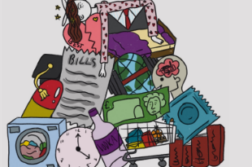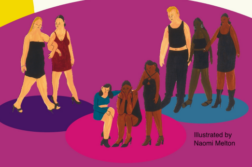The word ‘chav’ was birthed in a town in Kent called Chatham and became mainstream in the 1970s as locals would refer to the working class residents of Chatham as chavs. It was a derogatory term used against the working class for their mannerisms and outfits. When researching what a chav is, you will often find it defined as referring to someone who is working class, wears branded sportswear, exhibits loud and violent behaviour, and also uses Jamaican patois in their slang.
The word chav is frequently used by the media with seemingly no repercussions, despite it being a derogatory term to describe the working class. Sketches like Little Britain’s Vicky Pollard exemplify what the public perceive a chav to be. Pollard is a young working class woman who has had ‘6 kids with 7 different men‘. Whilst watching Little Britain, we are confronted with the use of the word chav and laugh at the expense of serious working class issues. Vicky is violent and had her first child at “12”; we laugh at this, despite knowing that the idea of a 12-year-old having a child is worrying.
The word chav diminishes the fact that working class individuals are more prone to teen pregnancies and violence due to the direct link between poverty and a poor education. This is most evident in a recent survey which showed that by the age of 11, only 3/4 of children from the poorest fifth of families reach the expected level of education by the end of Primary school, compared to 97% of children who reach this level from the richest fifth of families. Though this statistic is worrying and shows that children in poverty have fewer opportunities than the rich, we still laugh at the expense of the working class.
The media helps to further push the chav caricature, as demonstrated by comparing the media’s response to the Madeleine McCann disappearance with the response to the disappearance of Shannon Matthews. The Shannon Matthews case has now been solved, but the media’s portrayal of Shannon was vastly different to their portrayal of Madeleine.
When the story of Shannon’s disappearance was released, the media payed an excessive amount of attention to her background, focusing on how she was from a council estate and her mum had multiple kids with multiple different men. Her mum and her family were deemed ‘chavs’. The McCanns, however, were from a ‘respectable’ background – they were both doctors and middle-class, and were enjoying a holiday in Portugal with their middle-class friends. The media deemed this child more newsworthy than Shannon Matthews, whose mum was constantly under spotlight in the media for her appearance.
In the nine days following their disappearances, there were 465 press stories on Madeleine, compared to only 242 about Shannon, proving the classism in the media. More evidence is shown in The Sun‘s offered award for the children being found – £20,000 for Shannon, compared to £2.6 million for Madeleine. These children were both abducted, but due to their class their lives held different values.
Even when it was discovered that Shannon’s mother had staged the whole abduction, the media still focused upon her class and how it was a prime example of a ‘chav’ trying to con the system, despite the fact that the McCanns have made thousands of pounds from the disappearance of their child.
These examples show the harmful nature of using the word ‘chav’. The more we use the word. the more anti-working class sentiment we are spreading without realising. Allowing the term ‘chav’ to flourish only enables the upper classes to laugh at the expense of the working class, whilst also making the lives of those who are not working class more important than the lives of those from working class backgrounds.



